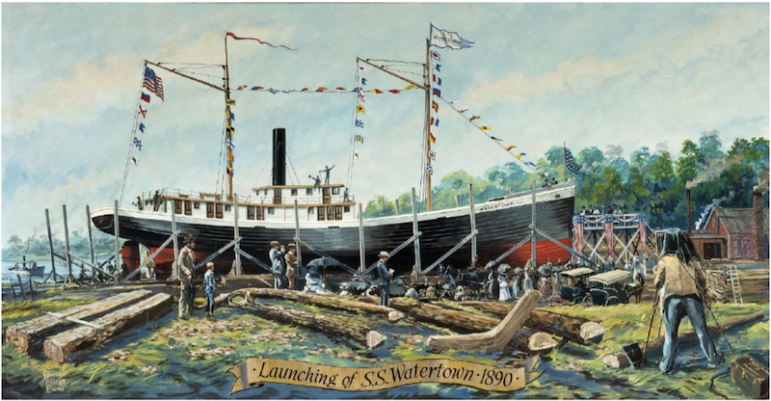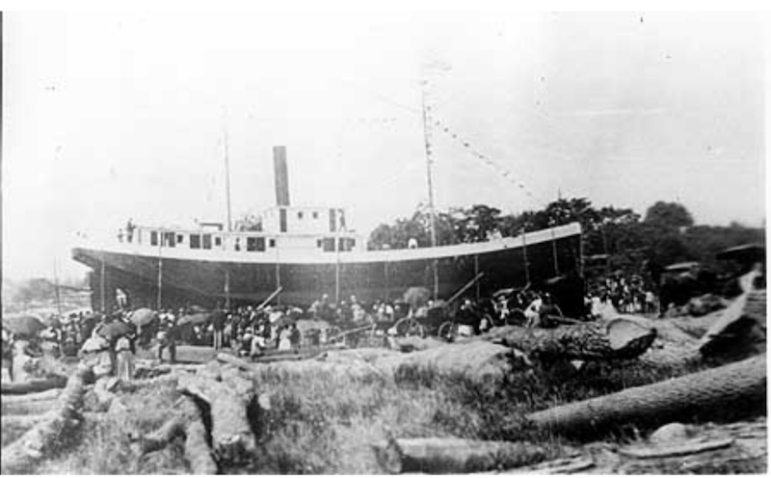
The following story is part of a series on local history provided by the Historical Society of Watertown. It was written by David J. Russo, for the April 2012 Historical Society newsletter, “The Town Crier.” At the time, David was the Historical Society Recording Secretary and Chair of the Watertown Historical Commission.
Did you know we had a ship? Watertown was a dynamic place in the 19th century and one of the manifestations of our ingenuity was the construction and launching of the S.S. Watertown here on July 30, 1890.
The ship wasn’t owned or used by the Town of Watertown itself, but it was lovingly named after the town by its owner John Cassidy, who lived at 227 North Beacon Street where the house still stands today. A whole article could be written about Cassidy’s life. He appears to have taken the Protestant work ethic to heart, owning and managing large real estate holdings in Watertown and Brighton, operating a wholesale liquor business in Boston and a saw mill here in town. Somehow, he had the time to oversee the construction of a ship. Cassidy was also one of Watertown’s Civil War veterans.
The S.S. Watertown was the first and only ship built here. Cassidy operated his shipyard on the Charles River, on what today would be the corner of Charles River Road and Palmer Street. At the time, a tributary ran to the river and this provided the perfect geography for ship building. Being a smart and thrifty man, Cassidy also located his saw mill next to the shipyard, creating a very short supply chain for this crucial commodity.
Did we need a ship? It was originally conceived that a coal wharf could be established in Watertown and that a ship could be used to transport that resource to Philadelphia. This, of course, sounds like an odd use and indeed, such a use never came to be. A ship was not economically viable for trips between Watertown and other destinations. Ultimately, the Watertown became part of the Boston & Lynn Transfer Company and ran excursion trips from Boston to Marblehead, Salem and Beverly in the summer and transported goods from Boston to Lynn at all other times.
The S.S. Watertown was a steam-powered ship that was 134 feet long, almost 21 feet at its greatest width and it could haul about 400 tons. It was designed by A.B. Boyles of East Boston and built by R.P. Hawkes of Weymouth. Much of the wood for the ship was harvested from the local area with the interior of the ship constructed of oak and the exterior clad in southern pine. At the time, it was reported that using these local sources of timber yielded a 50% savings in the cost of materials, certainly a value for our thrifty Mr. Cassidy.
The ship was flat-bottomed with three keels, one in the center and one running parallel on either side. This enabled the Watertown to navigate in shallower water. At the time, the Charles River was tidal and the level of the river varied, but this enabled the ship to easily operate at low
tide as needed.

The launching of the S.S. Watertown was a red-letter day for the town and was reported widely in the local and regional press, including The Boston Globe. Guests of honor included officials from Watertown, Newton, Waltham and Belmont and the event drew about 1,000 onlookers. The Town of Watertown presented Cassidy with a set of colors that would supplement the two already mounted on the ship: the U.S. flag at one mast and a pennant with the name “Watertown” standing out in bold relief on the other.
Rounding out the occasion were speeches from local dignitaries and Cassidy’s young daughter Katie, breaking a bottle of wine on the ship’s hull. As the Watertown descended into the Charles River to commence her working life, she did not get stuck in the mud as some detractors predicted, but sailed gracefully into the water, the pride of her native town following behind her.
There was an innate feeling that a new era of industry and commerce had begun and Watertown was driving it. After a day of speeches and a reception in the saw mill, the town went back to its life, confident in its Yankee ingenuity and place in the world.
Unfortunately, our pride was short-lived. Just over two years later, on September 28, 1892, as the ship was making its regular run to Lynn, fully loaded with groceries, furniture and other merchandise, a fire broke out on the S.S. Watertown. The captain, upon realizing the extent of the fire, ordered the ship to be beached on the shores of Winthrop to allow the passengers and crew to swim easily to safety.
One person, Mary Frances Carter of Chelsea, was killed in the incident. Reports indicate that she was terrified of having to jump overboard and her husband was forced to throw her overboard in an attempt to save her from the approaching fire. Unfortunately, she met her demise as she entered the water and struck her head on the propeller. As the ship continued to burn, it found its way to the shore of Winthrop and beached itself.
Already, the entire ship from stem to stern was engulfed in flames. Soon, the flames reached an oil tank that exploded and tore away the starboard side of the ship, exposing her hull. Officials tried to save some portion of the cargo but were unsuccessful. The ship was totally destroyed; the cargo a complete loss.
An investigation revealed that a defective steam boiler caused the fire: there was contact between the boiler’s pipes and the wooden frame of the ship. There should have been insulation that protected the ship, but there wasn’t. This steam boiler had been purchased used from another ship and had tragically caused a similar fire in its former craft. Whether Cassidy knew this fact or not is unknown, but the repetition of this incident was unconscionable.
The fire was reported not only in the local and regional press but also in The New York Times. It was certainly an injury to the pride of Cassidy and the town, especially because of the loss of life.
Nineteenth century Watertown was an enterprising community, which fomented and encouraged advancements in the political, religious, business and industrial realms. The S.S. Watertown was one such expression of the community’s progress and values. What are today’s?
Note: Around 1975, Watertown Savings Bank commissioned muralist Samuel Emrys Evans (1917-1997) to create a series of paintings representing Watertown’s history for the walls in the bank at 60 Main Street. Mr. Evans researched photographs in the archives at the Watertown Free Public Library and chose nine of them, and created stunning 4’ x 8’ paintings that hung in the bank for more than 30 years.
In 2012, the bank renovated their lobby, displacing the painting and making it necessary to find new homes for each mural. Carole Katz, then-Vice President of Marketing at the bank, joined with the Historical Society of Watertown to find new homes for these paintings. The paintings were all relocated to public buildings including Town Hall, the Police Station, the Coolidge School Apartments, Perkins School for the Blind, the Senior Center and Brigham House. The painting above can be viewed in the Senior Center.
In order to assure there was a permanent record of the paintings, Watertown Savings Bank joined with historians Joyce Kelly, Marilynne Roach and David Russo to publish a booklet about the paintings. This soft cover booklet includes full color prints of the paintings, as well as narratives of the historic subjects and can be purchased through the Historical Society of Watertown for $5. To purchase it, please contact Joyce at joycekel@aol.com.
Really enjoyed this well-written account of a piece of our history. Plan to purchase the booklet of paintings!